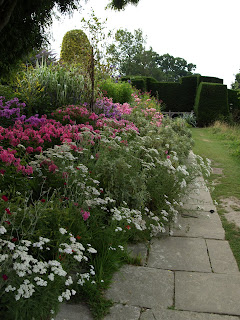
 Last month I did manage to visit one fantastic garden and on this grey, murky day I just thought I'd share some sunny photos of that day in October!
Last month I did manage to visit one fantastic garden and on this grey, murky day I just thought I'd share some sunny photos of that day in October!West Dean Gardens are the grounds to West Dean College in West Sussex which is a renowned College offering post-graduate and short courses in various arts, crafts and garden design. The gardens include a wonderfully restored Victorian kitchen garden. That put it on the list for a visit as part of researching my final project, a former frameyard at the National Trust's Mottisfont - see my last blog post
 Visiting West Dean really brought that heyday of Victorian walled gardens to life, a time when producing fruit, vegetables and cut flowers for the big house was a year round operation on a grand and energy intensive scale. At the height of exotic fruit production, having pineapples on the table was like having a Rolls on the drive. Seeing the restored glasshouses, coldframes, pits for forcing pineapples and melons and trained fruit trees at West Dean, as well as the beds packed with vegetables and cut flowers gave me a lot of inspiration.
Visiting West Dean really brought that heyday of Victorian walled gardens to life, a time when producing fruit, vegetables and cut flowers for the big house was a year round operation on a grand and energy intensive scale. At the height of exotic fruit production, having pineapples on the table was like having a Rolls on the drive. Seeing the restored glasshouses, coldframes, pits for forcing pineapples and melons and trained fruit trees at West Dean, as well as the beds packed with vegetables and cut flowers gave me a lot of inspiration.  The beautiful weather really helped - it made the glass architecture shine and all the produce look even more amazing. Here are a few photos. Definitely worth a visit and the courses there look amazing if you want something creative.
The beautiful weather really helped - it made the glass architecture shine and all the produce look even more amazing. Here are a few photos. Definitely worth a visit and the courses there look amazing if you want something creative.Above: gourds in wonderful and weird shapes on display. What a great word gourd is.
Above right: the fab glasshouses which I became faintly obsessed with taking pictures of. Figs are growing in the top one and a late vine still has grapes on it in the one shown below. Peaches, nectarines and the like are also grown in these wonderful buildings.
Left: I don't know what they are putting in their compost, but something is working - all the veg looks amazing. Giant everything!
Below top: the orchard in the late afternoon sun. This really inspired me for my project: I included an orchard meadow with spring bulbs and wildflowers.
Below middle: a restored pineapple pit. It would have been heated by putting manure in the trench around the edge(under the planks) and the heat would have gone through gaps in the bricks. So now you know.
Let the mild weather continue but some sunny weather please!
 |
| My mum in the Harold Peto pergola, a massive 300 feet long Edwardian masterpiece - also at West Dean |





























